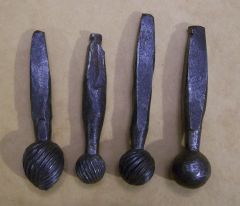-
Posts
2,092 -
Joined
-
Last visited
Content Type
Profiles
Forums
Articles
Gallery
Downloads
Events
Everything posted by Timothy Miller
-

What do you guys think?
Timothy Miller replied to 5starhobo (blake)'s topic in Anvils, Swage Blocks, and Mandrels
I would at most pay 350 for an anvil like that. -
If you really think about it they cost that much because they are worth it. You think there is some conspiracy to stop you from getting one. They are expensive because they are scarce, useful desirable, and generally well made from durable expensive materials. New ones reflect the cost of production plus the sellers profit (this is where they afford to eat) and transportation. More often then not they are worth what you paid for it you, can turn around and sell it for what you have in it. Is your car, computer or boat worth what you paid for it, nope. The real problem is many people just don't want it bad enough. Look at the things a master blacksmith can make on an anvil and meditate on that for a wile. There are good deals to be had but these come in their own time. A pristine anvil flying on gossamer wings will not alight upon your stump in a shaft of moon light. You got to beat the bushes man! hurt you back lifting it and perhaps tear the upholstery in you Buick to get one on the cheap. Remember run don't walk.
-

Microstructure of burnt steel
Timothy Miller replied to porkchop's topic in Heat Treating, general discussion
Wrought iron can be allover the road as far as carbon content. It was not made with modern quality controls what really makes something wrought iron is a fibrous structure running the bar. I have had wrought iron bars that spark tested as mild steel but when cut half way through and snapped it showed the heavy wood like grain. -
I had one like that it used a 7/16" U-bolt to hold it to the mount.
-
Its a good table to clamp tooling to for making repeat bends or other forming operations. It's usefulness would be wasted as a anvil base
-
dull read no more I have worked 100's of pounds of the stuff. If you go hotter it falls apart.
-
This is a poor idea it will not give you any advantage at the forge it does not have enough power or speed to move metal hot. I suggest you spend your time working at the forge you will see much more return for your efforts. When you have established what can be done by hand using skill and experience as a guide it is then time to move on to powered forging.
-
In a fair fight my money is on forging.
-
Its old enough to be from the civil war period. But the horns often broke off on their own. I have seen at least 10 like that in the north over the years. It there were tool marks showing intentional breakage you would have a case to make that claim.
-
That's a very nice vise. I wouldn't worry about the crack just keep an eye on it if it starts getting larger then grind it out and weld it. Make an mark a the end of the crack to see is it getting larger. It probably never will get bigger unless you really abuse it. It is probably an original manufacturing flaw.
-
Are you sure you don't have the space for a power hammer? I have seen small air hammers that had about the same foot print as a drill press. Build shelves move the scrap pile outside get a smaller quench tank. You can do it man!! Got any other excuses I need to obliterate. Once you get one you will wonder why didn't I do this sooner. So pawn the TV sell your blood and max out your credit cards and buy a stinking power hammer. The sooner you have one the sooner you will be more productive. Why wait?
-
Its more of a notch than a key way. I think it is actually called a toothed bolt. Most of the vices I have taken apart had them but I like to play with the really old ones.
-
Most vise bolts are keyed they have a small key under the head to prevent it from turning and loosening it fits into a cut out at the top of the hole. If the bolt gets loose it is more likely the jaws may wrack under heavy strain. Also if you don't use a keyed bolt you will be constantly tightening the bolt if you use the vise a lot. After you get the old bolt out you could cut it back and weld some new thread to the bolt to preserve the head with the key. If the jobs worth doing its worth doing right.
-
-

Hand crank drill press speed?
Timothy Miller replied to Daynee's topic in Drills, Post drills, Mag drills, etc
These parts can be made in a forge with no special tools. All it takes is time and a willingness to keep tiring till you get it right. -
You can draw out steel faster with a round faced hammer than a flat faced hammer. You can also draw out just as fast with a flat faced hammer by forging with a rounded surface under the steel by using the horn. The rounding hammer has a round face for drawing and a flat face for smoothing. Peens draw out steel at 90 degrees to the peen. I have several types of hammers I switch as needed. There is no one size fits all hammer.
-
Do not dismiss paying for instruction. You will progress much faster with a competent teacher. Many fab shops will give away steel scraps for coffee beer or doughnuts. I always give steel to aspiring smiths who darken my door as I typically have 10,000 lbs of material on hand.
-
Well the term leg vise makes a lot of scene when you think about it. It stands on a leg like a table, chair or person and it has jaws at the top like most creatures. Posts go floor to ceiling and support beams and lintels if you mounted a vice on a post you would run your hand into the post when you filed or have to stop when you wrapped a scroll. Unless you mounted it to your fence or mailbox but then you would be working to close to the road. Vices are mounted on stands or benches most of the time at least when used most effectively. Now I suppose a stump would make a good stand for a vise but you would have to cut down a tree then build your shop over it. Pedantic and proud :D.
-
Your right but people would understand each other if we tried to use the same terms for specialized tools. You ever try to get a job done with another guy who calls every tool by a nick name or callers it a thingy. Metal work even blacksmithing, requires a degree of precision to get the job done well. It helps when your working hot iron to ask for a tool and get what you asked for. What if you asked for a coarse file and the guy brought you a rasp you might get upset.
-
You mean a blacksmiths Leg vise? Never heard of a stump vise or a post vise for that matter at least not until I started reading I forge iron.
-

Broke 100# LG frame
Timothy Miller replied to Danny C's topic in Power Hammers, Treadle Hammers, Olivers
Don, I am making the assumption that you forge mostly knives? I would see nothing lacking in a 100 lb little giant to forge blades and billets. My hammer was $10,000 a reconditioned 100lb little giant runs about half that. I could see how many would see my machine as unnecessary and overly expensive. I run some fairly specialized tooling in my hammer. Fullers butchers swages closed dies texturing tooling and more. Since the bubble popped there has not been much in the way of forged ornamental work being done around me. I have had to be extremely flexible to keep the doors open and my guys working. You just don't have the height under the ram with a mechanical hammer to do all of the crazy work that comes in the door. I know this from experience I used to have a 75lb fairbanks I got real tired of adjusting the Pittman arm every time I wanted to forge thicker stock. I have seen modified mechanical hammers that worked as well as air hammers with longer arms and bigger springs and Bradlys and Beudries are very good hammers if you can find them. The reason we bought the hammer was not Tom Clark (god rest his soul) it was strictly a business decision. We wanted a hammer we could plug in and get to work and would present no limits in the size steel it was designed to forge. If you are running a shop with a pay roll tools that don't require lots fixing and set up really add the the bottom line. -

Broke 100# LG frame
Timothy Miller replied to Danny C's topic in Power Hammers, Treadle Hammers, Olivers
Your right Doc but often preheating is part of the brazing process and there is less thermal shock because a torch is only heating up the cast iron to the 2000/1700 degree range where an arc is about 10,000 degrees at its working end the torch heat is more diffuse also. I have repaired a bunch of cast iron stuff large and small. Brazing always seemed to have less problems. You just don't want the cast cool fast enough to convert into white cast iron. I have never seen a brazed part crack from thermal shock. -

Broke 100# LG frame
Timothy Miller replied to Danny C's topic in Power Hammers, Treadle Hammers, Olivers
I am a professional smith with a staff of 5. I started out using mechanical hammers and switched to an air hammer. I would never go back. The air hammer is a more productive machine and gives the smith more control over hard and soft blows. I have a 65kg say mak air hammer. Some mechanical hammers may hit slightly harder pound for pound but the lack in control. If I was told I had to go back I would feel like I had taken a major step backward. I love old machines but with the wide range of work I am forced take on in the new economy I need the versatility that an air hammer affords. The only mechanical I would entertain using in my shop would be a Bradly compact. Sometimes you have to overrule your staffs tastes and biases in the interest of over all health of the company. If I were going to repair it I would braze it then sister the frame with steel straps and plates. Grind everything out use steel pins to hold everything together then fill in the root with braze. You will have no pre/postheating issues and braze is easy to use. Use good bolts and steel strapping to take up the slack. I have seen some very old repairs done this way and they held up well. -
May 3 4 5, Northeast Blacksmiths at Ashoken with Frank Turley. You should really take the time to check this one out.

